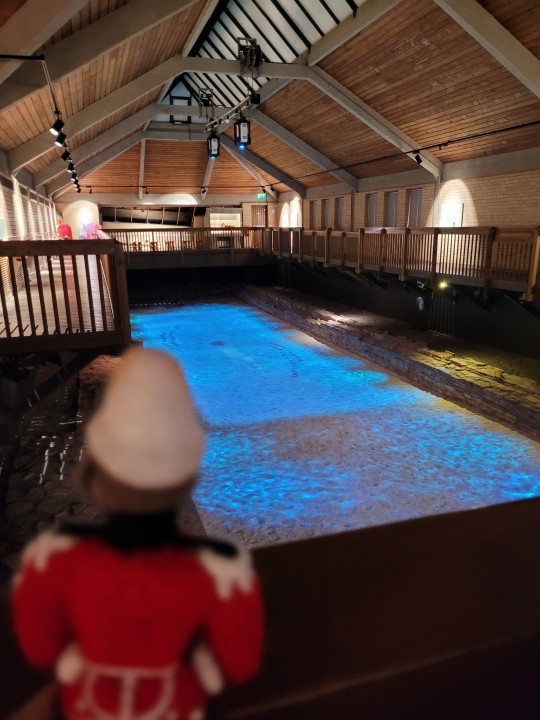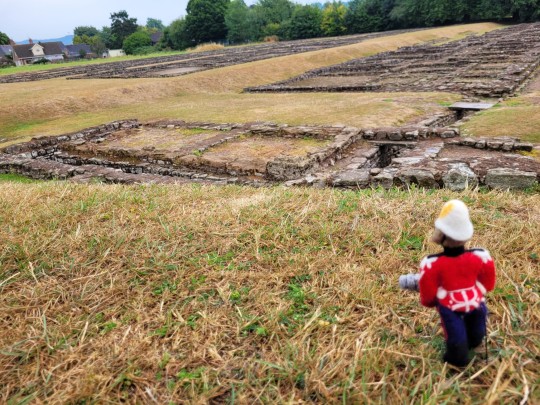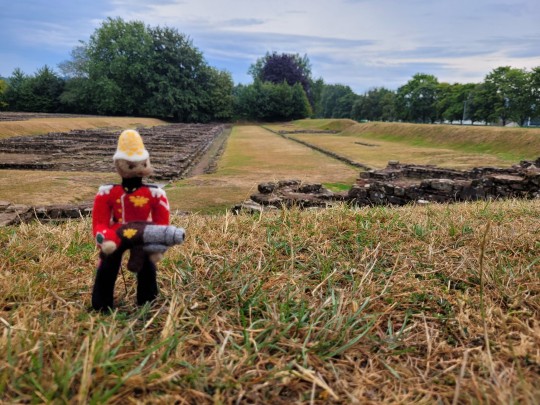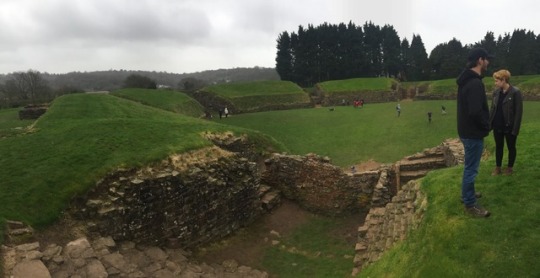#Roman Legionary Museum Caerleon
Text
The mighty Praetorian Guard visiting the Roman Legionary Museum Caerleon and Roman Fort. Looking for inspiration for the 41st Millennium!





Srg even got to meet the great leader Caesar himself!

#Roman Legionary Museum Caerleon#roman fort#praetorian guard#praetorian#games workshop#caesar#emperor#warhammer 40k#warhammer 40000#warhammer40k#imperial guard#astra militarum#Roman Legionary Museum#Caerleon#Roman Museum#Museum
3 notes
·
View notes
Text

Roman Legionary Helmet from Brigetio, Hungary, 1st Century CE, The National Roman Legion Museum, Caerleon, Wales
#roman#roman army#roman empire#roman living#roman helmet#roman metalwork#roman soldiers#roman wales#roman armour#archaeology#relic#artefact#wales#Caerleon#roman legion
231 notes
·
View notes
Photo




Caerleon • Caerwent
For our Romans in Britain field trip we made a hoof to Wales and looked at some (REALLY FREAKING COOL) Roman Ruins. We first went to Caerleon and looked through the Roman Baths they had excavated, which were in amazing condition. On some of the stones you could easily see some paw prints from both cats and dogs, as well as the foot print from the studs of a sandal of a Roman soldier. On our way back to the bus, we stopped at the museum which housed all of the artifacts from Caerleon Baths as well as other excavations done around the town.
Then after the Baths we walked to the most excavated Roman amphitheater in Britain. It kind of smelled like horse poop, but that’s a totally separate issue. The really cool thing was the completely excavated shrine, cell and stairs of the original Roman amphitheater. And the fact that it was built to seat about 6,000 people, shows that there are further excavations that could be done to unearth further history.
After looking at the amphitheater we wandered over to the ancient Roman barracks, where the foundations from the barracks were in absolutely perfect condition. One could easily see where the soldiers barracks were and where the houses for the legionaries/centurions were. We could even see the ovens on the other side of the ancient Roman street.
After looking at the barracks for a while, we hopped back on to the bus and went to Caerwent, a Welsh town situated among the Roman foundations of the previous Usk town. Though the wind was brutal, and I really should have worn a thicker coat, it was really cool to imagine the full lay out of a roman town rather than seeing various ruins. In Caerwent we saw the remains of a Villa/Shops as well as a Basilica/Forum and a temple. Seeing the temple so close to the Basilica was a little weird, but it makes sense now that I’m physically envisioning the layout.
If anyone wants to see a really good layout of a Roman town in Britain, Caerwent is a good town thats fully settled, whereas Caerleon was a good town for looking at a military town.
0 notes
Text
A Tale of Two Iscas
by Alison Morton
Whenever I visit a town I'm drawn to the museum, especially (and sometimes exclusively) to see if there is any Roman stuff. This is what a 'Roman nut' usually does. Woe betide anybody coming in between me and tesserae, Samian ware or a nice bit of Roman concrete. Last year in Exeter was a special treat because it was the second of the twin Iscas, the other one I'd never seen.
The Romans established a large castrum (fortified camp) named Isca around AD 55 at the southwest end of the Fosse Way as the base for the 5,000-man Legio II Augusta (Second Augustan Legion) originally led by Vespasian, later Roman emperor. Twenty years later they moved to Caerleon in Wales, which was also confusingly known as Isca. To distinguish the two, the Romans referred to Exeter as Isca Dumnoniorum after the name of the local tribe and Caerleon as Isca Augusta.
I'd visited Caerleon decades ago as a student when I'd been working on the archaeological dig at Usk, and more recently when I was at a writing conference. But I'd never visited its twin, Exeter.
Exeter – Isca Dumnoniorum
The name is a Latinisation of a Brythonic name describing flowing water (Uisc), in reference to the River Exe. Like many early settlements Exeter began as a place of dry land by a navigable river; in Exeter's case on a ridge ending in a spur overlooking the Exe. The bonuses were a fertile hinterland, a river full of fish and access to a large protected estuary and the open sea. Although there have been no major prehistoric finds, these advantages suggest the site was occupied early. Coins have been discovered from Hellenistic kingdoms, suggesting the existence of a settlement trading with the Mediterranean as early as 250 BC.
Isca Dumnoniorum Castrum
In mid first century Exeter, a civilian community (vicus or canabae) inhabited by local tribespeople and soldiers' 'unofficial' families, grew round the Roman camp, mostly to the northeast.
When Legio II Augusta left around AD 75 to go north to fight tribes in Wales, the camp grounds were converted for civilian purposes; its very large legionary bathhouse was demolished to make way for a forum, basilica and a smaller-scale bathhouse.
In the late 2nd century AD, the ditch and rampart defences around the old fortress were replaced by a bank and wall enclosing a much larger area, around 92 acres. The course of the Roman wall was used for Exeter's subsequent city walls; the stones are a mixture of Roman and medieval. About 70% of this wall remains, and most of its route can be traced on foot.
The settlement served as the tribal capital (civitas) of the Dumnonii and Isca Dumnoniorum seems to have been most prosperous in the first half of the 4th century: more than a thousand Roman coins have been found around the city and there is evidence for copper and bronze working, a stock-yard, and markets for the livestock, crops, and pottery produced in the surrounding area.
Trade with the Mediterranean continued bringing luxuries like wine and fine pottery. In the 3rd century AD new stone wall and gatehouses were built. Rich people lived in townhouses with costly mosaic floors; other areas of housing fell into disuse or were converted into farmyards.
Display of pottery and glassware, Exeter Museum
In the museum, the Roman military presence is testified by hooks from legionary helmets, knives, armour hinges, armour tie hooks, armour buckles and hinged fittings, belt buckles, legionary apron fittings, strap ends, tent pegs, and horse harness fittings. These are all small things of life then, but precious to us now for the story they tell. But beside those, the cases display a rich variety of military and civilian basins, strigils, pots, jars, cooking implements, even glassware. And of course, tiles, mosaics, plaster and stone remnants alongside domestic rings, brooches, weaving weights, board games, keys and styli. And, of course, silver coins. As in any other part of the Roman Empire, the pickings show a rich diversity and sheer numbers of objects that even humble people possessed.
Display of military clips, ties and buckles, Exeter museum
In 410 AD the last Roman soldiers left Britain to defend Rome against attacks by hostile tribes. By then Isca's suburbs were being abandoned; there are few remains from this time. Dates of coins discovered so far suggest a rapid decline: virtually none have been discovered with dates after AD 380. By around 500, the basilica had fallen down and Isca Dumnoniorum's busy urban life was over.
Circling back to AD 75, when the Legio II Augusta soldiers strapped on their marching boots and filed out of the castrum gate, I wonder what the effect was on the Devonian Isca. The heavy military presence was lifted; the drinking, rowdiness, the casual brutality, the gambling, testosterone, the whoring and the unwanted pregnancies. Many unofficial wives upped sticks and with their children followed the soldiers to their new home. However, the economic effect must have been significant for the the innkeepers, brothels, tailors, weavers, leather and knife suppliers, laundries and local food suppliers and grain merchants.
Caerleon – Isca Augusta (Isca Silurum)
The Brythonic name Isca referred to the River Usk which literally means 'river of flowing water' (tautology alert!). The suffix Augusta, an honorific title taken from the legion stationed there for 200 years, appears in the Ravenna Cosmography, a list of place-names covering the world from India to Ireland compiled by an anonymous cleric in Ravenna around ad 700. It's also referred to as Isca Silurum to differentiate it from Isca Dumnoniorum and because it lay in the territory of the Silures tribe. However, there is no evidence that this form was used during the Roman period. Caerleon, the name we know today, is derived from the Welsh for "fortress of the legion".
Isca Augusta was founded by Governor Sextus Julius Frontinus during the final campaigns against the native tribes of western Britain, notably the Silures in South Wales who had resisted the Romans' advance for over a generation.
It became the headquarters of the Legio II Augusta, a large fortress base on the typical rectangular castrum pattern and built initially with an earth bank and timber palisade. It remained their headquarters until at least 300 AD.
The camp interior was fitted out with the usual array of military buildings: a headquarters building, legate's residence, tribunes' houses, hospital, large bath house, workshops, barrack blocks, granaries and, unusually, a large amphitheatre.
The excavated amphitheatre
Britannia was one of the most heavily militarised provinces due to its frontier status and hostile neighbours. Isca Augusta is uniquely important for the study of the conquest, pacification and colonisation of the island. It was one of only three permanent legionary fortresses in later Roman Britain and, unlike the other sites at Chester and York, its archaeological remains are relatively undisturbed beneath fields and the town of Caerleon.
Excavations continue and one of the most exciting discoveries is a complex of very large monumental buildings outside the fortress between the River Usk and the amphitheatre. This new area of the canabae (settlement of traders, families and discharged soldiers) was previously completely unknown.
And in August 2011 it was announced that remains of a Roman harbour had been discovered in Caerleon. I have a little secret about that. Walking by the fortress wall in the fine rain a month before, loving and absorbing everything, I bumped into a fellow walker. We chatted and he obviously caught on that I was a 'Roman nut'. He told me he was a member of the University of Cardiff faculty involved in digging the site. Poor man! I bombarded him with questions.
Mosaic and pottery finds, Roman National Legion Museum
But as he was speaking to another enthusiast, he told me they were developing excavations as there had been indications there was much more to find. There always is, of course, but his was a humdinger. He revealed that remains of a Roman harbour had been found in a meadow by the river.. All very hush-hush, so please not to speak about it. I almost jumped up and down, but did manage to keep my dignity. You can look through the gallery of pictures for more images of what Roman Caerleon might have looked like.
Most of the sites I have been to are ruins, but there is memory in those stones. Touching walls, walking on mosaics, breathing the air of the place and sometimes seeing the same view they saw.
Prysg Field Barracks
The walls of Prysg Field Barracks at Caerleon, the only Roman legionary barracks visible in Europe are gone, but the foundations are still there showing their outline. The amphitheatre – the largest ever uncovered in Britain and once romantically (and mistakenly) said to have been the site of Arthur's Round Table of Camelot – is grassed over. The timber grandstand which would have seated some 6,000 shouting, cursing and cheering legionaries and townspeople is no more. These and the legionaries' swimming pool, the make you wonder who the people were who trod the same pathways, swam in the pool, placed bets, got drunk, made assignations. The light grey sky, the misty rain, the waves and slopes of the landscapes, your hand touching the stone and concrete in a place where so many people had lived and worked two thousand years ago give you something that no book or picture or film can give you.
Sources:
Bidwell, Paul T. (1980). Roman Exeter: Fortress and Town. Exeter City Council.
Hoskins, W. G. (2004). Two Thousand Years in Exeter (Revised and updated ed.)
National Roman Legion Museum, Caerleon
University of Cardiff, Dr Peter Guest
BBCwww.bbc.com/news/uk-wales-14628286 [Accessed 20/2/2017]
For more on Caerleon discoveries see youtu.be/nwx00pe2HH8 [Accessed 20/2/2017]
[Photographs - author's own, one time use allowed for this article]
~~~~~~~~~~
Alison Morton has misspent decades clambering over Roman sites throughout Europe. She holds a MA History, blogs about Romans and writing. Now she writes, cultivates a Roman herb garden and drinks wine in France with her husband of 30 years.
She writes the Roma Nova thriller series featuring modern Praetorian heroines. She blends her deep love of Roman history with six years' military service and a life of reading crime, adventure and thriller fiction.
All five books have been awarded the BRAG Medallion. SUCCESSIO, AURELIA and INSURRECTIO were selected as Historical Novel Society's Indie Editor's Choices. AURELIA was a finalist in the 2016 HNS Indie Award. The sixth, RETALIO, is due out in April 2017.
Buying links: alison-morton.com/books-2/buying-links/
Blogsite: alison-morton.com
Facebook: www.facebook.com/AlisonMortonAuthor/
Twitter: twitter.com/alison_morton
Hat Tip To: English Historical Fiction Authors
0 notes
Text




Roman Iron Legionary Helmet, 1st Century CE, Hungary, The National Roman Legion Museum, Caerleon, Wales.
#roman helmet#roman soldiers#roman army#roman craft#roman metalwork#roman armour#roman fort#roman design#roman empire#roman style#roman legionary#roman wales#creative#education#cross arts#cross curricular#community#identity#belonging#ritual#archaeology#artefact#relic#ancient cultures#Caerleon
395 notes
·
View notes